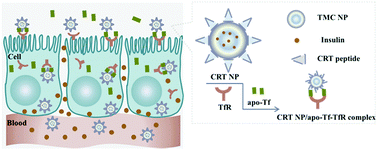当前位置:
X-MOL 学术
›
J. Mater. Chem. B
›
论文详情
Our official English website, www.x-mol.net, welcomes your
feedback! (Note: you will need to create a separate account there.)
Iron-mimic peptide converts transferrin from foe to friend for orally targeting insulin delivery†
Journal of Materials Chemistry B ( IF 6.1 ) Pub Date : 2017-12-18 00:00:00 , DOI: 10.1039/c7tb02450a Min Liu 1, 2, 3, 4, 5 , Lei Wu 1, 2, 3, 4, 5 , Wei Shan 1, 2, 3, 4, 5 , Yi Cui 1, 2, 3, 4, 5 , Yuan Huang 1, 2, 3, 4, 5
Journal of Materials Chemistry B ( IF 6.1 ) Pub Date : 2017-12-18 00:00:00 , DOI: 10.1039/c7tb02450a Min Liu 1, 2, 3, 4, 5 , Lei Wu 1, 2, 3, 4, 5 , Wei Shan 1, 2, 3, 4, 5 , Yi Cui 1, 2, 3, 4, 5 , Yuan Huang 1, 2, 3, 4, 5
Affiliation

|
Oral administration of targeted nanoparticles (NPs) has great potential in biomedical applications and displays several putative advantages for protein and peptide drug delivery. However, one important limiting factor is the presence of free ligands or endogenous counterparts, which competitively inhibit the ligand–receptor interaction of the actively targeted NPs. We hypothesize that NPs targeted to the transferrin (Tf) and transferrin receptor (TfR) complex may overcome this competitive inhibition. To test this hypothesis, herein, we develop CRT-peptide-modified NPs, which target the Tf–TfR complex, and compare their performance with HAI-peptide-modified NPs which only target TfR. The results of our study show that in the presence of free Tf, the CRT NPs exhibit higher cellular internalization, better Caco-2 monolayer transportation, and increased villi absorption compared with the HAI NPs. Meanwhile, the epithelium transportation of the CRT NPs is lower compared with the HAI NPs in the absence of free Tf, which demonstrates the assistance of Tf. The better intestinal absorption of the CRT NPs is induced by the unique properties of the CRT ligand, which could target the Tf–TfR complex with a non-canonical allosteric directed mechanism. The in vivo study demonstrates a 1.9-fold higher bioavailability for the CRT NPs compared with the HAI NPs. Our results verify that this targeting strategy not only avoids the competitive inhibition of endogenous Tf, but also converts endogenous Tf from foe to friend for active targeting.
中文翻译:

铁模拟肽将转铁蛋白从仇敌转变为朋友以口服靶向胰岛素递送†
口服靶向纳米颗粒(NPs)在生物医学应用中具有巨大潜力,并且在蛋白质和肽类药物的递送方面显示出一些公认的优势。但是,一个重要的限制因素是游离配体或内源性对应物的存在,它们竞争性地抑制了主动靶向NP的配体-受体相互作用。我们假设针对转铁蛋白(Tf)和转铁蛋白受体(TfR)复合物的NPs可能克服这种竞争性抑制作用。为了验证这一假设,在本文中,我们开发了靶向Tf-TfR复合物的CRT肽修饰的NP,并将其与仅靶向TfR的HAI肽修饰的NPs的性能进行了比较。我们的研究结果表明,在存在游离Tf的情况下,CRT NPs表现出更高的细胞内在化,更好的Caco-2单层运输,与HAI NP相比,绒毛吸收增加。同时,在没有游离Tf的情况下,CRT NPs的上皮运输率比HAI NPs低,这证明了Tf的帮助。CRT NPs的更好的肠道吸收是由CRT配体的独特特性引起的,该特性可以通过非规范的变构定向机制靶向Tf–TfR复合物。这体内研究表明,与HAI NP相比,CRT NP的生物利用度高1.9倍。我们的结果证明,这种靶向策略不仅避免了内源性Tf的竞争性抑制,而且还可以将内源性Tf从敌人转变为朋友,从而实现主动靶向。
更新日期:2017-12-18
中文翻译:

铁模拟肽将转铁蛋白从仇敌转变为朋友以口服靶向胰岛素递送†
口服靶向纳米颗粒(NPs)在生物医学应用中具有巨大潜力,并且在蛋白质和肽类药物的递送方面显示出一些公认的优势。但是,一个重要的限制因素是游离配体或内源性对应物的存在,它们竞争性地抑制了主动靶向NP的配体-受体相互作用。我们假设针对转铁蛋白(Tf)和转铁蛋白受体(TfR)复合物的NPs可能克服这种竞争性抑制作用。为了验证这一假设,在本文中,我们开发了靶向Tf-TfR复合物的CRT肽修饰的NP,并将其与仅靶向TfR的HAI肽修饰的NPs的性能进行了比较。我们的研究结果表明,在存在游离Tf的情况下,CRT NPs表现出更高的细胞内在化,更好的Caco-2单层运输,与HAI NP相比,绒毛吸收增加。同时,在没有游离Tf的情况下,CRT NPs的上皮运输率比HAI NPs低,这证明了Tf的帮助。CRT NPs的更好的肠道吸收是由CRT配体的独特特性引起的,该特性可以通过非规范的变构定向机制靶向Tf–TfR复合物。这体内研究表明,与HAI NP相比,CRT NP的生物利用度高1.9倍。我们的结果证明,这种靶向策略不仅避免了内源性Tf的竞争性抑制,而且还可以将内源性Tf从敌人转变为朋友,从而实现主动靶向。











































 京公网安备 11010802027423号
京公网安备 11010802027423号